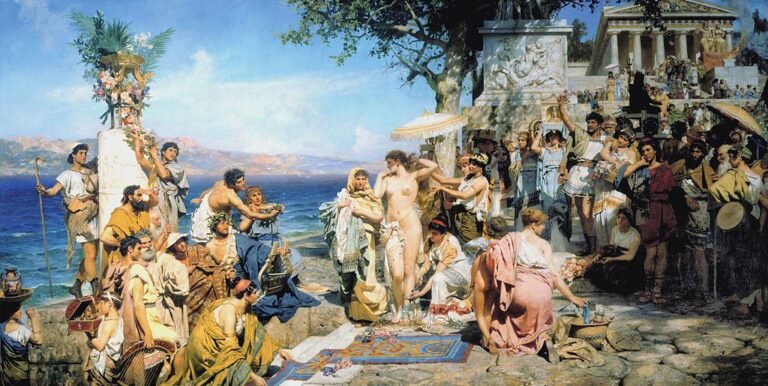Contenus
ToggleIn short
La fête de la Skira ou Skirophoria dans le calendrier de l’Athènes antique, étroitement associée à la Thesmophoria, marquait la dissolution de l’ancienne année en mai/juin. A Athènes, le dernier mois de l’année était Skirophorion, après la fête.

Skira, la fin de l'année athènienne
Sa caractéristique la plus importante était la procession qui menait d’Athènes à un endroit appelé Skiron près d’Eleusis, à laquelle la prêtresse d’Athéna, le prêtre de Poséidon, et plus tard, le prêtre d’Hélios, ont pris part, sous un dais de cérémonie appelé le skiron, retenu par les Eteoboutadai. Leur temple commun sur l’Acropole était l’Erechtheum, où Poséidon incarné en tant qu’Erechtheus restait une présence numineuse.
À Skiron, il y avait un sanctuaire dédié à Demeter/Kore et un à Athéna.
En tant que fête de dissolution, la Skira était une fête proverbiale de licence, dans laquelle les hommes jouaient aux dés, mais un temps aussi de jeûne diurne, et d’inversion de l’ordre social, car les liens du mariage étaient suspendus, tandis que les femmes se baguaient. ensemble et quittaient les quartiers où elles étaient habituellement enfermées, pour manger ensemble de l’ail « selon la coutume ancestrale », et pour sacrifier et festoyer ensemble, aux dépens des hommes.
La Skira sert de décor à la comédie d’Aristophane Ecclesiazusae (393 av. J.-C.), dans laquelle les femmes saisissent l’opportunité offerte par le festival, pour ourdir leur complot visant à renverser la domination masculine.
Social networks
On this day, the Athenians celebrated Skira. The priestess of Athena, the priest of Poseidon and the priest of Helios were performing a ceremony marking the end of the year. The male/female roles were suspended that day. #mythology #myth #legend #calendar #Athens #Skira
Picture
